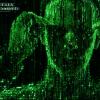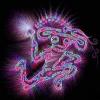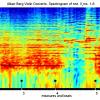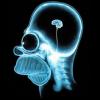The role of hippocampus in the pathophysiology of bipolar disorder
Frey, Benicio N.a e; Andreazza, Ana C.a b; Nery, Fabiano G.c f g; Martins, Marcio R.d; Quevedo, Joãod; Soares, Jair C.h; Kapczinski, Flávioa
Abstract
Bipolar disorder (BD) is thought to be associated with abnormalities within discrete brain regions associated with emotional regulation, particularly in fronto-limbic-subcortical circuits. Several reviews have addressed the involvement of the prefrontal cortex in the pathophysiology of BD, whereas little attention has been given to the role of the hippocampus. This study critically reviews data from brain imaging, postmortem, neuropsychological, and preclinical studies, which suggested hippocampal abnormalities in BD. Most of the structural brain imaging studies did not find changes in hippocampal volume in BD, although a few studies suggested that anatomical changes might be restricted to the psychotic, pediatric, or unmedicated BD subgroups. Functional imaging studies showed abnormal brain activation in the hippocampus and its closely related regions during emotional, attentional, and memory tasks. This is consistent with neuropsychological findings that revealed a wide range of cognitive disturbances during acute mood episodes and a significant impairment in declarative memory during remission. Postmortem studies indicate abnormal glutamate and GABA transmission in the hippocampus of BD patients, whereas data from preclinical studies suggest that the regulation of hippocampal plasticity and survival might be associated with the therapeutic effects of mood stabilizers. In conclusion, the available evidence suggests that the hippocampus plays an important role in the pathophysiology of BD.
Exercise training increases size of hippocampus and improves memory
Author Affiliations
- Kirk I. Ericksona,
- Michelle W. Vossb,c,
- Ruchika Shaurya Prakashd,
- Chandramallika Basake,
- Amanda Szabof,
- Laura Chaddockb,c,
- Jennifer S. Kimb,
- Susie Heob,c,
- Heloisa Alvesb,c,
- Siobhan M. Whitef,
- Thomas R. Wojcickif,
- Emily Maileyf,
- Victoria J. Vieiraf,
- Stephen A. Martinf,
- Brandt D. Pencef,
- Jeffrey A. Woodsf,
- Edward McAuleyb,f, and
- Arthur F. Kramerb,c,1
Edited* by Fred Gage, Salk Institute, San Diego, CA, and approved December 30, 2010 (received for review October 23, 2010)
Abstract
The hippocampus shrinks in late adulthood, leading to impaired memory and increased risk for dementia. Hippocampal and medial temporal lobe volumes are larger in higher-fit adults, and physical activity training increases hippocampal perfusion, but the extent to which aerobic exercise training can modify hippocampal volume in late adulthood remains unknown. Here we show, in a randomized controlled trial with 120 older adults, that aerobic exercise training increases the size of the anterior hippocampus, leading to improvements in spatial memory. Exercise training increased hippocampal volume by 2%, effectively reversing age-related loss in volume by 1 to 2 y. We also demonstrate that increased hippocampal volume is associated with greater serum levels of BDNF, a mediator of neurogenesis in the dentate gyrus. Hippocampal volume declined in the control group, but higher preintervention fitness partially attenuated the decline, suggesting that fitness protects against volume loss. Caudate nucleus and thalamus volumes were unaffected by the intervention. These theoretically important findings indicate that aerobic exercise training is effective at reversing hippocampal volume loss in late adulthood, which is accompanied by improved memory function.
Citation
Database: PsycINFO
[ Journal Article ]
Size, shape, and orientation of neurons in the left and right hippocampus: Investigation of normal asymmetries and alterations in schizophrenia.
Zaidel, Dahlia W.; Esiri, Margaret M.; Harrison, Paul J.
The American Journal of Psychiatry, Vol 154(6), Jun 1997, 812-818.
Abstract
- Examined whether left and right hippocampal neuronal size, shape, and orientation are normally asymmetrical or asymmetrically affected in schizophrenia. The authors examined postmortem tissue from the left and right hippocampus of 17 normal Ss (aged 22–84 yrs) and 14 Ss with schizophrenia (aged 28–83 yrs). The size, shape, and variability in orientation of pyramidal neurons in hippocampal subfields CA1-CA4 was measured. Both neuronal size and shape showed significant effects of diagnosis and a 3-way interaction between diagnosis, hemisphere, and subfield. Neurons of the schizophrenic Ss were smaller than those of the normal Ss in the left CA1, left CA2, and right CA3 subfields; their shape differed from that of the normal Ss in the left CA1, left subiculum, and right CA3 subfields. Neurons in the CA3 genu in the schizophrenic Ss were less variable on the right than on the left. In the normal Ss, except for larger neurons in the left than in the right CA2 subfield and some left-right differences in variability of neuronal orientation, no statistically significant asymmetries were observed. The data confirm that hippocampal neuronal size is decreased in schizophrenia and reveal that the shape of neurons is altered. (PsycINFO Database Record © 2012 APA, all rights reserved)
Edited by Sholrak, 11 June 2013 - 04:38 PM.





















































